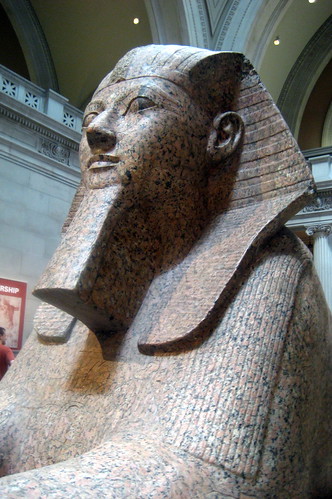NYC – Metropolitan Museum of Art: Sphinx of Hatshepsut

Image by wallyg
Sphinx of Hatshepsut
Joint reign of Hatsheput and Thutmose III (ca. 1479-1458 B.C.)
Western Thebes, Deir el-Bahri Grantie
Metropolitan Museum of Art, Rogers Fund, 1931 (31.3.1666)
This colossal granite sphinx portrays the female Egyptian pharaoh Hatshepsut with the body of a lion and a human head wearing a nemes headcloth and royal beard. The use of the sphinx to represent the king dates back to the Old Kingdom and the Great Sphinx of Giza. The sculptor has carefully observed the powerful muscles of the lion as contrasted to the handsome and attractive idealized face of the queen. It was one of six royal sphinxes that lined the processional way leading to the queen’s mortuary temple at Deir el-Bahri. Late in his reign, Hatshepsut’s co-ruler and eventual successor, Thutmose III, had ordered that all her statues be removed from the temple, smashed to pieces and discarded.
Excavated by the Museum’s Egyptian Expedition in the 1920′s and early 1930′s, it was found smashed into thousands of fragments and buried in pits near the temple. Its reconstruction was a major achievement of twentieth-century archaelogy. As it stands now, it weighs more than seven tons.
**
The Metropolitan Museum of Art‘s permanent collection contains more than two million works of art from around the world. It opened its doors on February 20, 1872, housed in a building located at 681 Fifth Avenue in New York City. Under their guidance of John Taylor Johnston and George Palmer Putnam, the Met’s holdings, initially consisting of a Roman stone sarcophagus and 174 mostly European paintings, quickly outgrew the available space. In 1873, occasioned by the Met’s purchase of the Cesnola Collection of Cypriot antiquities, the museum decamped from Fifth Avenue and took up residence at the Douglas Mansion on West 14th Street. However, these new accommodations were temporary; after negotiations with the city of New York, the Met acquired land on the east side of Central Park, where it built its permanent home, a red-brick Gothic Revival stone "mausoleum" designed by American architects Calvert Vaux and Jacob Wrey Mold. As of 2006, the Met measures almost a quarter mile long and occupies more than two million square feet, more than 20 times the size of the original 1880 building.
In 2007, the Metropolitan Museum of Art was ranked #17 on the AIA 150 America’s Favorite Architecture list.
The Metropolitan Museum of Art was designated a landmark by the New York City Landmarks Preservation Commission in 1967. The interior was designated in 1977.
National Historic Register #86003556
Tags:Hatshepsut, Metropolitan, Museum, sphinx


0 comments:
Post a Comment